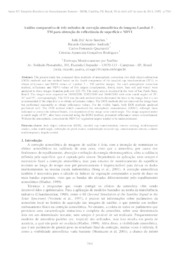Análise comparativa de três métodos de correção atmosférica de imagens Landsat 5 - TM para obtenção de reflectância de superfície e NDVI.
Análise comparativa de três métodos de correção atmosférica de imagens Landsat 5 - TM para obtenção de reflectância de superfície e NDVI.
Autoria: SANCHES, I. D. A.; ANDRADE, R. G.; QUARTAROLI, C. F.; RODRIGUES, C. A. G.
Resumo: The present study has compared three methods of atmospheric correction, two dark object subtraction (DOS) methods and one method based on the fourth component of the tasseled cap transformation (TC4), to obtain reflectance and NDVI values of Landsat 5 ? TM satellite images. For each atmospheric correction method, reflectance and NDVI values of five targets (crop/pasture, forest, straw, bare soil and water) were analyzed in three images (Landsat path-row 222-75). The study area is localized in the west of Sao Paulo State, Brazil. The images were acquired on 29/10/2009, 02/02/2010 and 26/06/2010 with solar zenith angles of 28°, 34° and 55°, correspondingly. The TC4 was the only method which eliminated the haze in the image, but it is not recommended if the objective is to obtain reflectance values. The DOS methods did not removed the image haze but performed reasonably to obtain reflectance values. For the visible bands, both DOS methods analyzed performed well. The DOS method which considered the atmospheric transmittance (DOS2), although more indicated to correct the infrared bands, it is dependent of the image solar zenith angle. The image acquired under a zenith angle of 55°, after been corrected using the DOS2 method, presented reflectance values overestimated. Without the atmospheric correction the NDVI of vegetation targets tended to be underestimated.
Ano de publicação: 2011
Tipo de publicação: Artigo em anais e proceedings
Unidade: Embrapa Territorial
Observações
1 - Por padrão são exibidas publicações dos últimos 20 anos. Para encontrar publicações mais antigas, configure o filtro ano de publicação, colocando o ano a partir do qual você deseja encontrar publicações. O filtro está na coluna da esquerda na busca acima.
2 - Para ler algumas publicações da Embrapa (apenas as que estão em formato ePub), é necessário ter, no celular ou computador, um desses softwares gratuitos. Sistemas Android: Google Play Livros; IOS: iBooks; Windows e Linux: software Calibre.
Acesse outras publicações
Acesse a Base de Dados da Pesquisa Agropecuária (BDPA) para consultar o acervo completo das bibliotecas da Embrapa.

